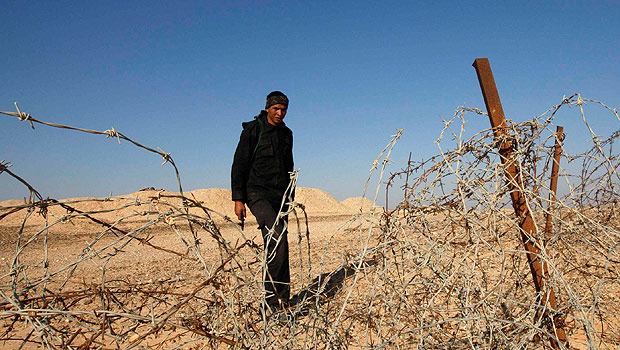Critics accuse Israel of trying to turn away bona fide refugees and predicted the facility, which will be designed to hold up to 10,000 detainees, would become a squalid refugee camp. The Cabinet minister in charge of prisons said correctional authorities were ill-equipped to run the facility.
But other officials said authorities cannot let thousands of economic migrants enter illegally each year, take jobs from Israelis and dilute the country’s Jewish character.
Prime Minister Benjamin Netanyahu told his Cabinet before the vote that the proposed center is part of a multi-pronged approach that will include construction of a barrier along thinly patrolled areas of the 130-mile (220-kilometer) Israeli-Egyptian border, which began last week, and heavy fines on people who employ illegal workers.
The barrier is also designed to keep out militants.
“We have to stop this growing influx that threatens Israelis’ jobs and changes the character of the state,” Netanyahu said.
Refugees would not be turned away. And the center, where the migrants would be housed, fed and receive medical care, would be a “humanitarian solution” for dealing with them until they are repatriated or sent to a third country, he said. The facility is to be completed in six months.
Until now, Israel has responded with a patchwork of stopgap measures.
According to government estimates, about 13,000 Africans will illegally enter Israel this year, joining more than 20,000 others who came between 2006 and 2009.
Without government intervention, the number could reach 30,000 a year by 2015, Cabinet secretary Tzvi Hauser told Israel Radio on Sunday. In addition to the African migrants, there are about 120,000 foreign workers with expired visas now in Israel, working illegally, the government and activists say.
Most migrants come from Eritrea, Sudan and other impoverished and conflict-ridden African countries. Human rights workers say the Africans appear to be racing to cross the border before Israel completes the border fence.
Officials say most migrants come looking for work and have become absorbed into the country’s sizable illegal work force. They often earn extremely low wages and live in abominable conditions.
But human rights workers say most are not economic migrants. And they accuse officials of not reviewing applications for political asylum.
“They don’t want to,” said Sigal Rozen of the Hotline for Migrant Workers.
Interior Ministry spokeswoman Sabine Haddad said with its limited staff power, the ministry first reviews applications of migrants from China, Thailand and other countries who came to Israel to work and therefore can be deported. It does not review the applications of immigrants from Eritrea and Sudan because Israel will not repatriate them at this time because of conditions there, even though they don’t qualify as refugees, Haddad said.
Rozen’s group and The Association for Civil Rights in Israel sent Netanyahu a letter last week calling the proposed center “a refugee camp, nothing more than a ghetto.” Plans to expel migrants have rankled some Israelis, who don’t want their country — founded in part as a sanctuary for Holocaust survivors — to turn away people from repressive, war-torn states.
Thousands of migrants have paid Egyptian smugglers, who reportedly demand as much as $10,000 to sneak them across the desert frontier. Hauser told Israel Radio that Israel does not have an agreement with Egypt to turn all the illegals back into Egypt’s Sinai peninsula, which borders Gaza.
Over the weekend, the Israel branch of Physicians for Human Rights accused Bedouin traffickers in Sinai of routinely raping migrants, subjecting them to electric shocks, burning them with iron bars and locking some in sweltering containers without food or water until they die.
They based the allegations on a significant number of accounts of abused migrants treated in Israel.
The stream of migrants began as a trickle in 2005, when hundreds entered. As stories of their new lives spread, more came.
Egypt allows Israel to turn back only those migrants caught along a limited section of the border.
Those who are not turned back are sent to a prison in southern Israel that can hold 2,000 inmates. Migrants are released when the prison becomes overcrowded — now, after about two months, though in the past, when the influx was lighter, they’d be held up to a year, Rozen said After their release, they are not given permission to work, though the government so far has looked the other way when they take under-the-table jobs to survive.










